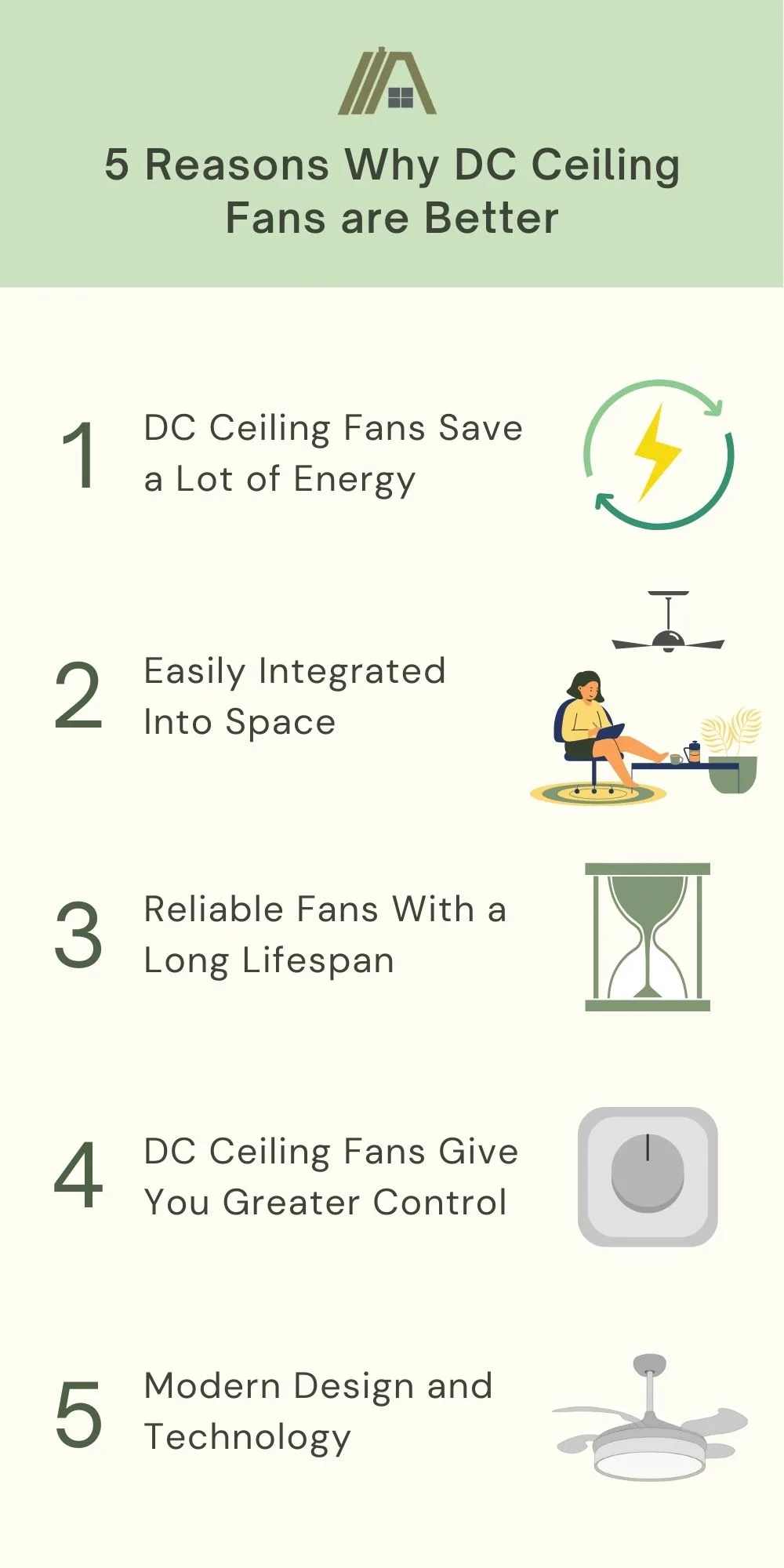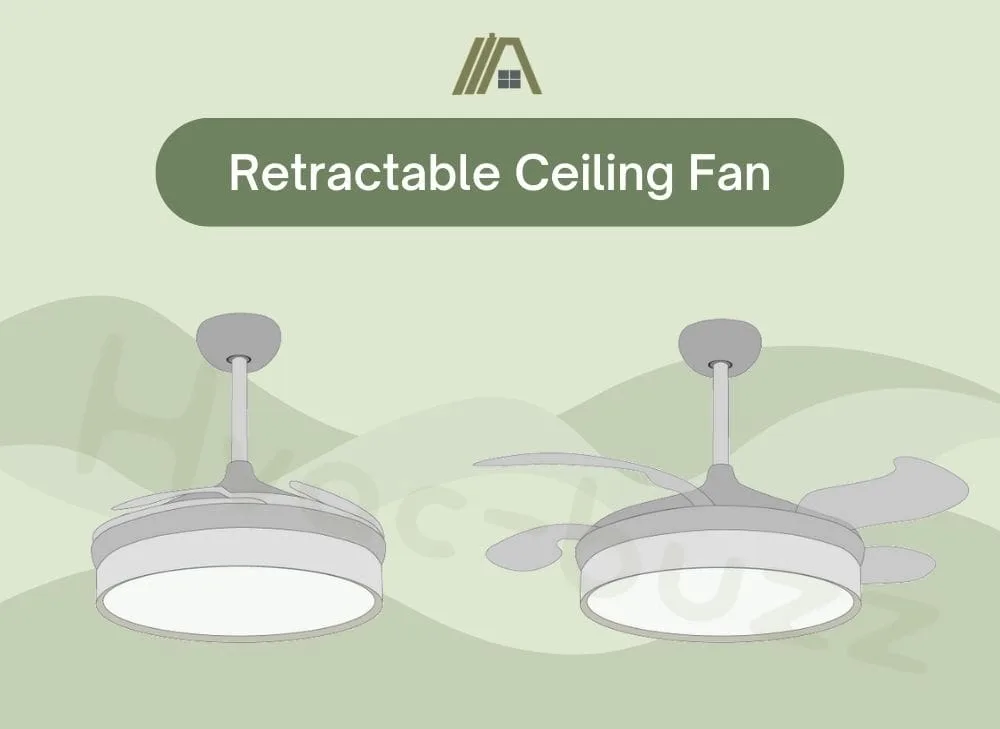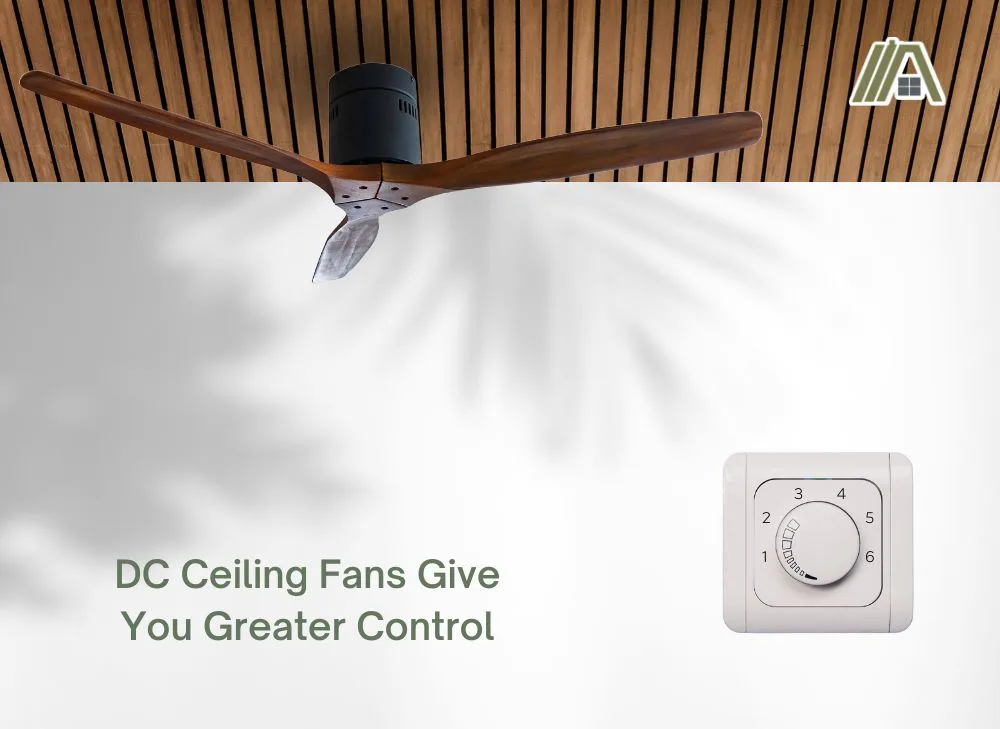When electricity was invented, there was quite a fierce competition between two inventors/scientists, Thomas Edison and Nikola Tesla. Edison invented direct current (DC) and Tesla Invented alternating current (AC). After various smear campaigns, AC was deemed the best for supplying the general population because it travels better than DC. But, just because AC is better for this job, doesn’t mean that DC is useless. Here are 5 reasons why DC ceiling fans have the edge over their AC counterparts.

DC ceiling fans are:
- More energy efficient
- Easily integrated into a space
- Reliable and long-lasting
- Adapted to provide users with greater control
- Well-suited to modern design and technology

1. DC Ceiling Fans Save a Lot of Energy
DC ceiling fans operate using motors powered by a direct current that only flows in one direction. AC changes direction at fifty to sixty times a second. One direction means a greater voltage and power, but changing directions helps prevent power loss over distances.
The exact mechanisms of this are a little more complex than we need for the sake of this article. Suffice it to say that a certain amount of current can produce more power in a DC motor than in an AC motor under the same conditions.
In the case of our ceiling fans, this means that DC fan motors use less electricity to produce the same effects as an AC ceiling fan motor, making them more energy efficient.
In addition, DC fans have a magnet system that uses a combination of electricity and magnetic fields to turn the fan blades instead of just relying on electricity.
See below comparison between popular sized, 52″ fans driven by AC and DC motors.
| Ceiling Fan Motor | Power Consumption | CFM Produced | Fan speed Setting |
| AC | 112 W | 6 200 | High |
| DC | 30 W | 6 500 | High |
| DC Advantage | 73% (Less power used) | 4% (More CFM) |
As indicated above, the DC fan shows a significant saving in electricity consumption while simultaneously delivering more cubic feet per minute of airflow, making the energy efficiency of a DC fan two-fold.
The cost savings realized through the lower power consumption of the DC fan, along with the extended useful life of the unit, makes the initial investment worth every cent.
While DC fans may be more effective, the general population is still supplied with AC electricity because it’s still better at traveling long distances. This necessitates the use of a transformer with a DC fan, to convert the current from AC before feeding it to the fan.
2. Easily Integrated Into Space
On the whole, DC ceiling fans are less bulky than AC fans. This is because the efficiency of DC motors means that you can effectively use a smaller motor in a certain space. This lends itself to compact and sleeker fan designs that are more appropriate for small spaces, rooms with low ceilings, and minimalist décor styles.
The additional torque lends itself well to fan designs with short but broad blades, even retractable blades when space is minimal.

DC fan motors are also exceptionally quiet, and don’t emit the buzzing noise so often heard from AC motors running at low speeds. This is great in bedrooms where the sound of a ceiling fan can disturb light sleepers. There are also just people who hate the white noise of a ceiling fan but enjoy the benefits thereof.
3. Reliable Fans With a Long Lifespan
DC ceiling fans are reliable and last long because DC motors don’t have parts that rub against each other, so nothing can wear out and less friction means less heat generation. AC motors, on the other hand, tend to run hot and generate more friction due to the high operating voltage of the alternating current configuration.
In addition to converting AC to DC, the DC motor’s transformer also reduces the voltage. Depending on the model fan, it reduces the motor voltage to 5, 12, 24, or 48 volts. The low voltage current used to power the motor produces very little heat, prolonging the motor life.
Moreover, the alternating current creates high levels of electromagnetic interference, which adds to the stresses placed on the motor components, and AC fans utilize capacitors that require replacement over time.
The higher number of fan speed setting options of the DC fans, some being slower than AC fans, enables you to run the fan at even lower speeds so that the motor lasts longer as it doesn’t run as hard as an AC ceiling fan.
4. DC Ceiling Fans Give You Greater Control
Ceiling fans with DC motors offer more fan speed options than traditional AC fans. The AC ceiling fan relies on altering the frequency of the motor to change the fan speed. Regulating the frequency is difficult, so most AC ceiling fans only offer three or four fan speed options.
The DC ceiling fans’ motor speed is determined by the voltage supplied to the motor, which is far easier to do than manipulating the frequency. The DC fan speed options have increased to six or more, depending on the make of the fan. This is so exclusive to DC fans that it can be used as an identifying feature.

DC fans come standard with a remote control that offers more control than most AC fans. The DC fan’s remote even reverses the fan’s direction for winter modes.
In the past, changing the AC fan’s direction had to be done manually by flipping a switch on the fan while balancing on a ladder or chair. If you prefer this option, wall-mounted controls are available for certain models in addition to a remote control.
DC fans are quicker at reaching the operating speed and also slow down and stop very quickly when turned off.
5. Modern Design and Technology
Modern ceiling fan design and technology have taken an old concept that’s been around for a very long time and re-designed and modernized the ceiling fans as we knew them.
Global DC technological advancements, no doubt fuelled by electric vehicle popularity, have significantly improved DC motor performance. Better performance has resulted in smaller motors being needed to turn our ceiling fans.
The compact motor size is great news for fan designers as ceiling fans no longer need to be chunky and heavy. Today, ceiling fans are compact, sleek, light, and allow for modern designs. Advancements in materials allow for fantastic blade designs, while the electronics used in DC ceiling fans are the newest technology.
Outstanding energy efficiency, many different styles and designs, ease of use, a long lifespan, and significantly increased levels of comfort are traits that set the DC fan apart from the old AC ceiling fan.
Sources
https://www.popularmechanics.com/home/a15895571/ceiling-fan-disassembly/https://homeguides.sfgate.com/many-amps-ceiling-fan-draw-87340.html

